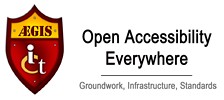Mobile devices are everywhere. On a typical tube ride to the regional office in London, I see loads of different devices. You can easily recognise the Amazon Kindle; you see the old type with buttons, and the more modern version with its touch screen. Other passengers read electronic books with Android and Apple tablets. Other commuters study their smart phones with intensity, and I’m fascinated with what is becoming possible with the bigger screen phones, such as the Samsung Note (or phablets, as I understand they’re called). Technology is giving us both convenience and an opportunity to snatch moments of reading in the dead time of travel.
I have a connection with a module which is all about accessible online learning (H810 module description). In the context of the module, accessibility is all about making materials, products and tools usable for people who have disabilities. Accessibility can also be considered in a wider sense, in terms of making materials available to learners irrespective of their situation or environment. In the most recent presentation of H810, the module team has made available much of the learning materials in eBook or Kindle format. The fact that materials can be made available in this format can be potentially transformative and open up opportunities to ‘snatch’ more moments of learning.
An event I attended on 11 February 2014, held in the university library, was all about sharing research and practice about the use of mobile devices. I missed the first presentation, which was all about the use of OU Live (an on-line real time conferencing system) using tablet devices. The other two presentations (which I’ve made notes about) explored two different perspectives: the perspective of the student, and the perspective of the associate lecturer (or tutor).
(It was also interesting to note that the event was packed to capacity; it was standing room only. Mobile technology and its impact on learning seems to be a hot topic).
Do students study and learn differently using e-readers?
The first presentation I managed to pay attention to was by Anne Campbell who had conducted a study about how students use e-readers. Her research question (according to my notes) was whether users of these devices could perform deep reading (when you become absorbed and immersed in a text) and active learning, or alternatively, do learners get easily distracted by the technology? Active learning can be thought of carrying out activities such as highlighting, note taking and summarising – all the things that you used to be able to do with a paper based text book and materials.
Anne gave us a bit of context. Apparently half of OU postgraduate students use a tablet or e-reader, and most use it for studying. Also, half of UK households have some kind of e-reader. Anne also told us that there was very little research on how students study and learn using e-readers. To try to learn more, Anne has conducted a small research project to try to learn more about how students consume and work with electronic resources and readers.
The study comprised of seventeen students. Six students were from the social sciences and eleven students were studying science. All were from a broad range of ages. The study was a longitudinal diary study. Whenever students used their devices, they were required to make an entry. This was complemented with a series of semi-structured interviews. Subsequently, a huge amount of rich qualitative data was collected and then analysed using a technique known as grounded theory. (The key themes and subjects that are contained within the data are gradually exposed by looking at the detail of what the participants have said and have written).
One of the differences between using e-readers and traditional text books is the lack of spatial cues. We’re used to the physical size of a book, so it’s possible to (roughly) know where certain chapters are once we’re familiar with its contents. It’s also harder to skim read with e-readers, but on the other hand this may force readers to read in more depth. One comment I’ve noted is, ‘I think with the Kindle… it is sinking in more’. This, however, isn’t true for all students.
I’ve also noted that there clear benefits in terms of size. Some text books are clearly very heavy and bulky; you need a reasonably sized bag to move them around from place to place, but with an e-reader, you can (of course) transfer all the books that you need for a module to the device. Other advantages are that you can search for key phrases using an e-reader. I’ve learnt that some e-readers contain a built in dictionary (which means that readers can look up words without having to reach for a paper dictionary). Other advantages include a ‘clickable index’ (which can help with the navigation). Other more implicit advantages can include the ability to change the size of the text of the display, and the ability to use the ‘voice readout’ function of a mobile device (but I don’t think any participants used this feature).
I also noted that e-readers might not be as well suited for active learning for the reasons that I touched on above, but apparently it’s possible to perform highlights and to record notes within an ebook.
My final note of this session was, ‘new types of study advice needed?’ More of this thought later.
Perspectives from a remote and rural AL
Tamsin Smith, from the Faculty of Science, talked about how mobile technology helps her in her role as an associate lecturer. I found the subject of this talk immediately interesting and was very keen to hear learn about Tamsin’s experiences. One of the modules that Tamsin tutors on consists of seven health science books. The size and convenience of e-readers can also obviously benefit tutors as well as students.
On some modules, key documents such as assignment guides or tutor notes are available as PDFs. If they’re not directly available, they can be converted into PDFs using freely available software tools. When you have got the documents in this format, you can access them using your device of choice. In Tamsin’s case, this was an iPad mini.
On the subject of different devices, Tamsin also mentioned a new app called OU Anywhere, which is available for both iOS and Android devices. After this talk, I gave OU Anywhere a try, downloading it to my smartphone. I soon saw that I could access all the core blocks for the module that I tutor on, along with a whole bunch of other modules. I could also access videos that were available through the DVD that was supplied with the module. Clearly, this appeared to be (at a first glance) pretty useful, and was something that I needed to spend a bit more time looking at.
Other than the clear advantages of size and mobility, Tamsin also said that there were other advantages. These included an ability to highlight sections, to add notes, to save bookmarks and to perform searches. Searching was highlighted as particularly valuable. Tutors could, for example, perform searches for relevant module materials during the middle of tutorials.
Through an internet connection, our devices can allow access to the OU library, on line tutorials through OU Live (as covered during the first presentation that I missed), and tutor group discussion forums allowing tutors to keep track of discussions and support students whilst they’re on the move. This said, internet access is not available everywhere, so the facility to download and store resources is a valuable necessity. This, it was said, was the biggest change to practice; the ability to carry all materials easily and access them quickly.
One point that I did learn from this presentation is that there is an ETMA file handler that available for the iPad (but not one that is official sanctioned or supported by the university).
Final thoughts
What I really liked about Anne’s study was its research approach. I really liked the fact that it used something called a diary study (which is a technique that is touched on as a part of the M364 Interaction Design module). This study aimed to learn how learning is done. It struck me that some learners (including myself) might have to experiment with different combinations of study approaches and techniques to find out what works and what doesn’t. Study technique (I thought) might be a judgement for the individual.
When I enrolled on my first postgraduate module with the Open University, I was sent a book entitled, The Good Study Guide by Andrew Northedge (companion website). It was one of those books where I thought to myself, ‘how come it’s taken me such a long time to get around to reading this?’, and, ‘if only I had read this as an undergraduate, I might have perhaps managed to get a higher score in some of my exams’. It was packed filled with practical advice about topics as time management, using a computer to study, reading, making notes, writing and preparing for exams.
It was interesting to hear from Anne’s presentation that studying using our new-fangled devices is that little bit different. Whilst on one hand we lose some of our ability to put post it notes between pages and see where our thumbs have been, we gain mobility, convenience and extra facilities such as searching.
It is very clear that more and more of university materials can now be accessed using electronic readers. Whilst this is likely to be a good thing (in terms of convenience), there are two main issues (that are connected to each other) that I think that we need to bear in mind.
The first is a very practical issue. It is: how do you get the materials onto our device? Two related questions are: how can we move our materials between different devices? and, how do we effectively manage the materials once we have saved them to our devices? We might end up downloading a whole set of different files, ranging from different module blocks, assignments and other guidance documents. It’s important to figure out a way to best manage these files: we need to be literate in how we use our devices. (As an aside, these questions loosely connect with the nebulous concept of the Personal Learning Environment).
The second issue relates to learning. In the first presentation, Anne mentioned the term ‘active learning’. The Good Study Guide contains a chapter about ‘making notes’. Everyone is different, but I can’t help but think that there’s an opportunity for ‘practice sharing’. What I mean is that there’s an opportunity to share stories of how learners can effectively make use of these mobile devices, perhaps in combination with more traditional approaches for study (such as note taking and paraphrasing). Sharing tips and tricks about how mobile devices can fit into a personalised study plan has the potential to show how these new tools can be successfully applied.
A final thought relates to the broad subject of learning design. Given that half of all households now have access to e-readers of one form or another (as stated in the first presentation I’ve covered) module teams need to be mindful of the opportunities and challenges that these devices can offer. Although this is slightly away from my home discipline and core subject, I certainly feel that there needs to be work to be done to further understand what these challenges and opportunities might be. I’m sure that there has been a lot more work carried out than I am aware of. If you know of any studies that are relevant, please feel free to comment below.
Video recordings of these presentations are available through the university Stadium website.

